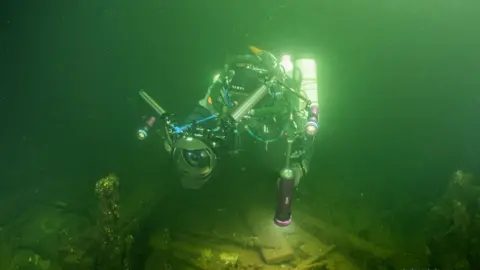100 bottles of champagne found in 19th Century wreck
When divers in the Baltic Sea first saw the wreck on the sonar, they thought it was a fishing boat.
But when they went to investigate, they found a 19th Century sailing ship, “loaded to the sides” with champagne, wine, mineral water and porcelain.
They counted more than 100 bottles of champagne in the wreck, off the coast of Sweden.
And now Tomasz Stachura, of Polish diving group Baltitech, believes the shipment could have been destined for a Russian tsar.
Baltitech, which specialises in exploring shipwrecks in the Baltic, described the find as “treasure”.
Mr Stachura, leader of the team, said: “I’ve been a diver for 40 years. From time to time, you see one or two bottles.
“But I’ve never seen crates with bottles of alcohol, and baskets of water, like this.”
The find was made about 20 nautical miles (37km) south of the Swedish island of Oland.
Two divers had said they would do “a quick dive” but then were gone for nearly two hours.
“So we already knew that there was something very interesting on the bottom,” Mr Stachura added.
The clay water bottles, showing the brand name of German company Selters, helped them date the wreck to 1850 to 1867.
While champagne would be of more interest to many today, mineral water was an exclusive product “treated almost like medicine” which “only found its way to royal tables”, said Mr Stachura.
“Its value was so precious that transports were escorted by the police.”
Mr Stachura told the BBC he believes the goods could have been heading for the table of Russia’s Tsar Nicholas I – who is reported to have lost one of his ships in the area in 1852.
 Tomasz Stachura / Baltictech
Tomasz Stachura / Baltictech“That would explain why the ship had this cargo – which was all very exclusive,” he said.
“Usually, when we find wrecks the cargo is very cheap.”
He thinks the ship was heading across the Baltic to either Stockholm or St Petersberg – which would again tie in with the theory.
“A dive itself only takes about 20 minutes,” he said. “But then diving into the archives is what can be more interesting.
“In the future, maybe we will know more about this wreck.”
As for the champagne – and prestigious mineral water – Mr Stachura believes both would be drinkable today.
For now, the treasure is staying where it is, with underwater archaeologists called in to assist. Swedish authorities have been notified, and administration also has to be done before it can be brought to the surface.
“It had been lying there for 170 years so let it lie there one more year,” said Mr Stachura.



